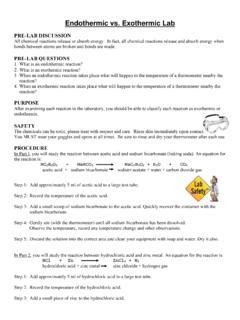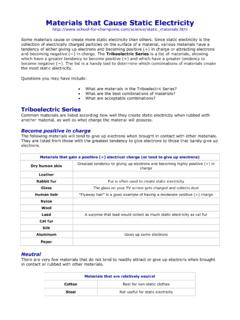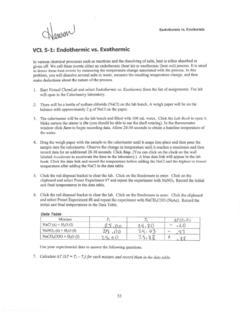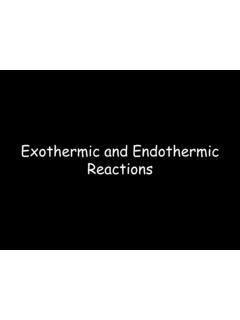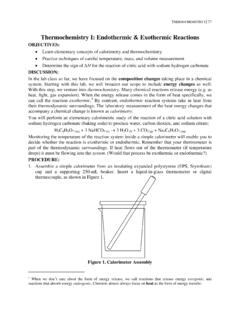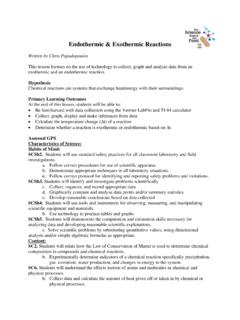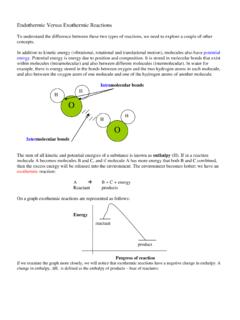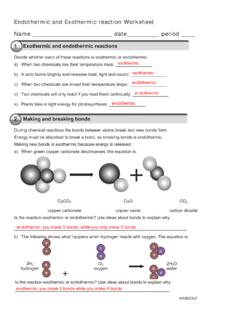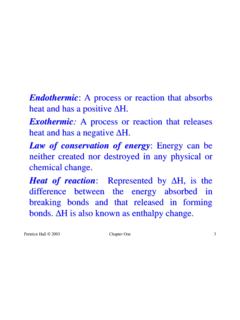Transcription of Endothermic/Exothermic Lab - Jayne Heier
1 Endothermic/Exothermic Lab PRE-LAB DISCUSSION All chemical reactions release or absorb energy. Chemical reactions that release energy in the form of heat are called exothermic reactions . Some chemical reactions absorb energy and are called endothermic reactions . PURPOSE After examining each reaction in the laboratory, you should be able to classify each reaction as exothermic or endothermic . SAFETY The chemicals can be toxic, please treat with respect and care. Rinse skin immediately upon contact. You MUST wear your goggles at all times. Be sure to rinse and dry your thermometer after each use. PROCEDURE In Part I, you will study the reaction between acetic acid and sodium bicarbonate (baking soda). An equation for the reaction is (Is it balanced? If not, try to balance the equation.)
2 : HC2H3O2 + NaHCO3 NaC2H3O2 + H2O + CO2 acetic acid + sodium bicarbonate sodium acetate + water + carbon dioxide gas Step 1: Add approximately 5 ml of acetic acid to a large test tube. Step 2: Record the temperature of the acetic acid. Step 3: Add a small scoop of sodium bicarbonate to the acetic acid. Step 4: Gently stir (with the thermometer) until all sodium bicarbonate has been dissolved. Observe the temperature, record any temperature change and other observations. Step 5: Discard the solution into the correct area and clean your equipment. In Part 2, you will study the reaction between hydrochloric acid and zinc metal. An equation for the reaction is (Is it balanced? If not, try to balance the equation.): HCl + Zn ZnCl2 + H2 hydrochloric acid + zinc metal zinc chloride + hydrogen gas Step 1: Add approximately 5 ml of hydrochloric acid to a large test tube.
3 Step 2: Record the temperature of the hydrochloric acid. Step 3: Add a small piece of zinc to the hydrochloric acid. Step 4: Gently stir (with the thermometer) until all zinc has been dissolved. Observe the temperature, record any temperature change and other observations. Step 5: Discard the solution into the correct area and clean your equipment. In Part 3, you will study the reaction between magnesium sulfate (Epsom salt) and water. An equation for the reaction is (Is it balanced? If not, try to balance the equation.): MgSO4 + H2O MgSO4 + H2 + O2 magnesium sulfate + water hydrogen gas + oxygen gas Step 1: Add approximately 10 ml of water to a large test tube. Step 2: Record the temperature of the water. Step 3: Add a small scoop of magnesium sulfate to the water.
4 Step 4: Gently stir (with the thermometer) until all magnesium sulfate has been dissolved. Observe the temperature, record any temperature change and other observations. Step 5: Discard the solution into the correct area and clean your equipment. In Part 4, you will study the reaction between calcium chloride and water. An equation for the reaction is (Is it balanced? If not, try to balance the equation.): CaCl2 + H2O CaCl2 + H2 + O2 calcium chloride + water calcium chloride + oxygen gas Step 1: Add approximately 10 ml of water to a large test tube. Step 2: Record the temperature of the water Step 3: Add a small piece(s) of calcium chloride to the water. Step 4: Gently stir (with the thermometer) until all calcium chloride has been dissolved.
5 Observe the temperature, record any temperature change and other observations. Step 5: Discard the solution into the correct area and clean your equipment. Endothermic/Exothermic Lab Name(s): OBSERVATIONS Part 1: Initial temperature of acetic acid _____ Temperature after adding sodium bicarbonate to the acetic acid_____ Did you feel a temperature change? _____ What did you observe during the reaction? Part 2: Initial temperature of hydrochloric acid_____ Temperature after adding zinc metal to the hydrochloric acid_____ Did you feel a temperature change? _____ What did you observe during the reaction? Part 3: Initial temperature of water_____ Temperature after adding magnesium sulfate to the water_____ Did you feel a temperature change?
6 _____ What did you observe during the reaction? Part 4: Initial temperature of water_____ Temperature after adding calcium chloride to the water_____ Did you feel a temperature change? _____ What did you observe during the reaction? ANALYSIS Part 1: The reaction of sodium bicarbonate and acetic acid is exothermic or endothermic ? What evidence do you have? Part 2: The reaction of zinc metal and hydrochloric acid is exothermic or endothermic ? What evidence do you have? Part 3: The reaction of magnesium sulfate and water is exothermic or endothermic ? What evidence do you have? Part 4: The reaction of calcium chloride and water is exothermic or endothermic ? What evidence do you have? Calcium chloride is as an ice-melting compound on sidewalks and city streets. Explain what is happening (use one of the terms- exothermic or endothermic in your explanation).
7 Does the energy go from the surrounding to the chemicals or from the chemicals to the surroundings in an exothermic reaction? GOING FURTHER Define endothermic and exothermic in your own words. Classify each of the following as an exothermic or endothermic process. Melting ice cubes _____ Burning a candle _____ Evaporation of water_____ Baking Bread _____ Splitting a gas molecule apart _____ Formation of snow in clouds _____Part 1: Balanced HC2H3O2 + NaHCO3 NaC2H3O2 + H2O + CO2 Part 2: Balanced HCl + Zn ZnCl2 + H2 Part 3: Balanced MgSO4 + H2O MgSO4 + H2 + O2 Part 4: Balanced CaCl2 + H2O CaCl2 + H2 + O2
